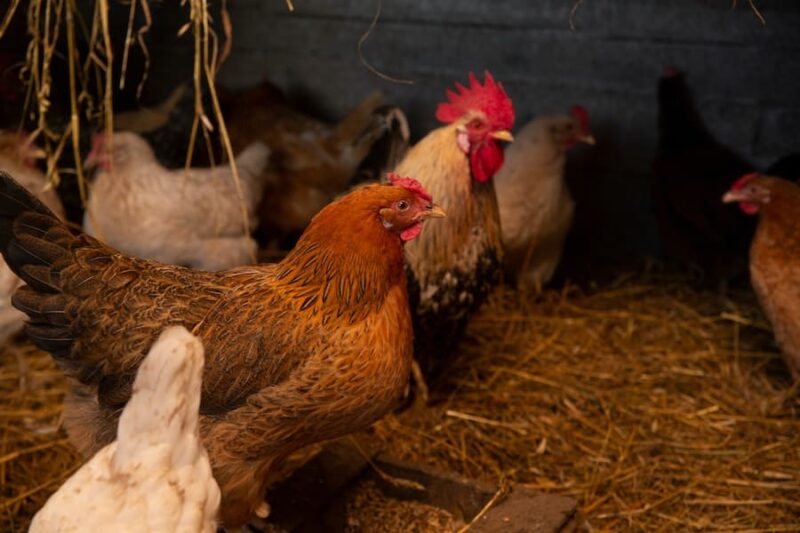Proper ventilation is crucial for maintaining a healthy and productive environment in a chicken coop. Inadequate ventilation can lead to a range of problems, including poor air quality, moisture buildup, and temperature extremes. This article aims to provide valuable insights into the ventilation needs of a chicken coop. By understanding the importance of ventilation and considering factors such as climate, coop size, and flock size, chicken owners can ensure optimal airflow for their feathered friends. Discover the key principles and practical solutions to promote better ventilation and overall well-being for chickens in this comprehensive guide.
How Much Ventilation Does A Chicken Coop Need?
The amount of ventilation a chicken coop needs depends on various factors such as climate, coop size, and flock size. Generally, a good rule of thumb is to provide at least 1 square foot of ventilation per 10 square feet of floor space. However, it is important to consider specific environmental conditions and the number of chickens to ensure adequate airflow and ventilation within the coop.
The Importance Of Ventilation In A Chicken Coop
Proper ventilation plays a vital role in maintaining a healthy and comfortable environment for chickens in a coop. It is essential for their overall well-being and productivity. Here are four key reasons why ventilation is of utmost importance:
Adequate ventilation ensures fresh air circulation, which helps remove harmful gases, such as ammonia, carbon dioxide, and dust, from the coop. These gases can accumulate in enclosed spaces, leading to respiratory issues, eye irritation, and other health problems for chickens. Good ventilation helps maintain optimal air quality and promotes respiratory health.
Chickens produce moisture through their respiration, droppings, and other bodily functions. Without proper ventilation, this excess moisture can accumulate inside the coop, leading to dampness, high humidity levels, and the growth of mold and bacteria. Ventilation helps reduce moisture buildup, preventing respiratory diseases, frostbite, and other moisture-related health issues in chickens.
Chickens are sensitive to temperature extremes. In hot weather, inadequate ventilation can trap heat inside the coop, leading to heat stress and even death. Conversely, during colder months, insufficient ventilation can cause condensation and drafts, leading to discomfort and potential frostbite. Proper ventilation helps regulate temperatures within the coop, providing a comfortable environment for the chickens year-round.
The accumulation of ammonia and other odorous gases in a poorly ventilated coop can result in strong, unpleasant odors. These odors not only affect the well-being of the chickens but can also cause discomfort to nearby residents or neighbors. Effective ventilation helps remove and disperse odors, maintaining a more pleasant and neighbor-friendly environment.
Factors Affecting Ventilation Requirements
Several factors influence the ventilation needs of a chicken coop. Understanding these factors is essential for determining the appropriate level of ventilation. Here are key considerations to keep in mind:
- Climate Considerations and Regional Variations: The climate in which the coop is located significantly impacts its ventilation requirements. In hot and humid regions, adequate ventilation is crucial to prevent heat stress and maintain comfortable temperatures. Conversely, in colder regions, ventilation needs to be balanced to prevent drafts and maintain warmth. Consider the specific challenges posed by your regional climate when determining the ventilation requirements for your chicken coop.
- Coop Size and Design: The size of the coop and its design play a role in ventilation needs. A larger coop generally requires more ventilation to ensure proper air circulation. Additionally, the coop’s design, including the placement of windows, vents, and openings, affects airflow patterns. Consider the dimensions and layout of your coop when determining the ventilation requirements and ensure that there are adequate openings for air exchange.
- Chicken Breed and Flock Size: The number and breed of chickens in the coop impact ventilation needs. Larger flocks generate more moisture and heat, necessitating increased ventilation. Moreover, some chicken breeds may have specific ventilation requirements due to their susceptibility to heat or cold. Take into account the size of your flock and the specific needs of your chicken breed when assessing ventilation needs.
Calculating Ventilation Needs
Determining the appropriate level of ventilation for a chicken coop involves calculating the air exchange rate, which is the amount of fresh air needed to replace the stale air within a given time frame. Here are guidelines to help you calculate the ventilation needs:
- Minimum Air Exchange Rate: A commonly recommended minimum air exchange rate is to provide 1 cubic foot per minute (CFM) of fresh air per chicken. This rate helps remove excess moisture, odors, and gases efficiently. For example, if you have 10 chickens, the minimum ventilation requirement would be 10 CFM.
- Maximum Air Exchange Rate: In hot climates or during extreme weather conditions, the ventilation needs may increase. A maximum air exchange rate of 4 CFM per chicken is often suggested to prevent heat stress. However, it’s crucial to strike a balance to avoid drafts and excessive cooling.
- Factors Influencing Calculation: Consider additional factors that can affect ventilation needs. These include the age of the chickens, as younger birds require more ventilation due to their higher metabolism and heat production. The coop’s location also plays a role, as a shaded coop in a cooler area may require less ventilation compared to one in direct sunlight.
Maintaining Proper Ventilation
Once you have established the appropriate ventilation for your chicken coop, it’s important to maintain it to ensure optimal air quality and comfort for your chickens. Here are key steps to help you maintain proper ventilation:
- Regular Inspection and Cleaning Routines: Periodically inspect the coop for any blockages or obstructions that may hinder airflow. Clear away any debris, such as dust, feathers, or cobwebs, that could accumulate near vents, windows, or openings. Keep the vents and openings clean and unobstructed to allow for smooth air circulation.
- Monitor Temperature, Humidity, and Ammonia Levels: Regularly monitor the temperature and humidity levels inside the coop. Use a thermometer and hygrometer to ensure the temperature is within the desired range and humidity is not excessive. Additionally, monitor ammonia levels using a handheld gas detector or ammonia test kit. High ammonia levels indicate poor ventilation and require immediate attention.
- Adjust Ventilation as Needed: Based on your monitoring results, adjust the ventilation system accordingly. If the temperature is too high, increase the airflow by opening windows or adjusting vents. In colder months, ensure that there are no drafts while still maintaining adequate air exchange. Fine-tune the ventilation system to strike the right balance for optimal conditions.
- Consider Seasonal Changes: Remember that ventilation needs may vary with seasonal changes. During hot summer months, increase airflow and provide shade to prevent heat stress. In colder seasons, ensure that ventilation is sufficient to remove excess moisture without causing drafts that could chill the chickens. Adjust ventilation settings as needed to accommodate seasonal variations.
- Regular Maintenance and Repairs: Perform routine maintenance on ventilation equipment, such as fans or exhaust systems, to keep them functioning properly. Clean or replace air filters as recommended by the manufacturer. Repair or replace any damaged or malfunctioning components to maintain an effective ventilation system.
Final Words
In conclusion, proper ventilation is crucial for the well-being of chickens in a coop. By understanding the factors affecting ventilation needs, calculating the appropriate airflow, and maintaining the ventilation system, you can create a healthy and comfortable environment for your feathered friends. Remember, regular monitoring and adjustments are key to ensuring optimal air quality and promoting the overall health and productivity of your chickens.
FAQ’s
How Can I Tell If My Chicken Coop Has Proper Ventilation?
Signs of proper ventilation include fresh air circulation, absence of strong odors, and optimal temperature and humidity levels. Additionally, monitoring the behavior and health of your chickens can provide clues. If they appear comfortable, have good respiratory health, and exhibit normal behavior, it suggests adequate ventilation.
Can I Rely Solely On Natural Ventilation Methods For My Chicken Coop?
Natural ventilation methods, such as windows, vents, and openings, can be effective in providing airflow. However, in certain climates or when specific ventilation needs are not met, mechanical ventilation systems may be necessary to supplement or enhance natural airflow.
What Are The Potential Risks Of Inadequate Ventilation In A Chicken Coop?
Inadequate ventilation can lead to poor air quality, high moisture levels, temperature extremes, and the accumulation of ammonia and other harmful gases. This can result in respiratory problems, decreased egg production, discomfort, and reduced chicken health and well-being.
Should I Adjust Ventilation During Different Seasons?
Yes, ventilation needs may vary with seasonal changes. During hotter months, increased ventilation and shade may be required to prevent heat stress. In colder months, ventilation should be balanced to remove excess moisture while avoiding drafts that could cause cold stress. Adjust ventilation settings accordingly to accommodate seasonal variations.
How Often Should I Clean And Inspect The Ventilation System?
Regular cleaning and inspection of the ventilation system are crucial. Perform routine checks at least once a month to ensure vents, windows, and openings are clean and unobstructed. Additionally, clean or replace air filters as recommended by the manufacturer and perform maintenance on mechanical ventilation equipment regularly.










